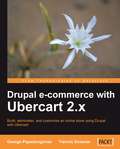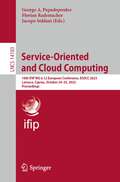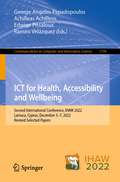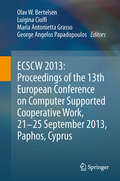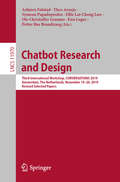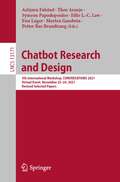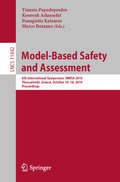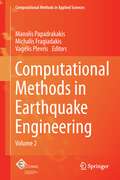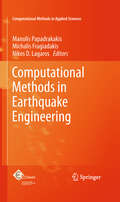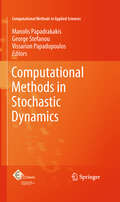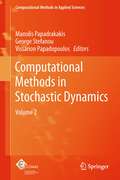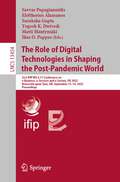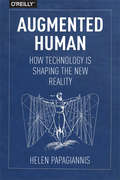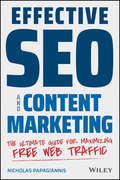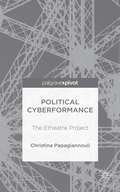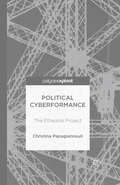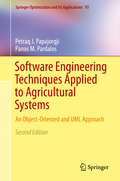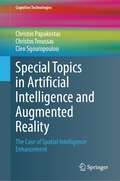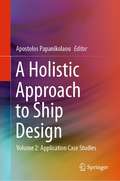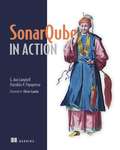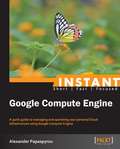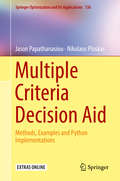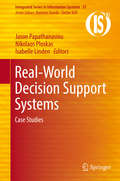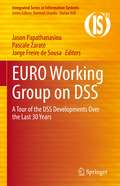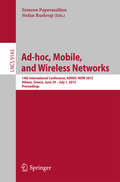- Table View
- List View
Drupal E-commerce with Ubercart 2.x
by George Papadongonas Yiannis DoxarasThis book will take you through the basics, like Drupal and Ubercart installation and common settings, and as we proceed through the chapters, we'll implement more advanced techniques. Whether you know Drupal or not, this book will be your guide to creating a powerful e-commerce web site. If you are a business owner wanting to create an eCommerce website for your company or to upgrade a company eShop to be easier to maintain and have advanced e-shopping capabilities, then this book is meant for you. You don't need any programming experience to use this book.
Service-Oriented and Cloud Computing: 10th IFIP WG 6.12 European Conference, ESOCC 2023, Larnaca, Cyprus, October 24–25, 2023, Proceedings (Lecture Notes in Computer Science #14183)
by George A. Papadopoulos Florian Rademacher Jacopo SoldaniThis book constitutes the constitutes the refereed proceedings of the 10th IFIP WG 6.12 European Conference on Service-Oriented and Cloud Computing , ESOCC 2023, held in Larnaca, Cyprus, during October 24–26, 2023. The 12 full papers and 4 short papers included in this book were carefully reviewed and selected from 40 submissions. They were organized in topical sections as follows: Microservices; Quality of Service; Service Orchestration; Edge Computing; PhD Symposium; and Industry Projects Track.
ICT for Health, Accessibility and Wellbeing: Second International Conference, IHAW 2022, Larnaca, Cyprus, December 5–7, 2022, Revised Selected Papers (Communications in Computer and Information Science #1799)
by George Angelos Papadopoulos Achilleas Achilleos Edwige Pissaloux Ramiro VelázquezThis book constitutes the refereed post-conference proceedings of the Second International Conference on ICT for Health, Accessibility and Wellbeing, IHAW 2022, held in Larnaca, Cyprus, in December 2022. The revised 14 full papers and 3 short papers presented were carefully selected from 33 submissions. The papers are thematically arranged in the following sections: Visual Impairment and ICT for Mobility; ICT and Student Health; ICT and Wellbeing and ICT & Health prevention
ECSCW 2013: Proceedings of the 13th European Conference on Computer Supported Cooperative Work, 21-25 September 2013, Paphos, Cyprus
by George Angelos Papadopoulos Maria Antonietta Grasso Luigina Ciolfi Olav W. BertelsenThis volume presents the proceedings of ECSCW 2013, the 13th European Conference on Computer Supported Cooperative Work. Each conference offers an occasion to critically review our research field, which has been multidisciplinary and committed to high scientific standards, both theoretical and methodological, from its beginning. The papers this year focus on work and the enterprise as well as on the challenges of involving citizens, patients, etc. into collaborative settings. The papers embrace new theories, and discuss known ones. They contribute to the discussions on the blurring boundaries between home and work and on the ways we think about and study work. They introduce recent and emergent technologies, and study known social and collaborative technologies. With contributions from all over the world, the papers in interesting ways help focus on the European perspective in our community. The 15 papers selected for this conference deal with and reflect the lively debate currently ongoing in our field of research.
Chatbot Research and Design: Third International Workshop, CONVERSATIONS 2019, Amsterdam, The Netherlands, November 19–20, 2019, Revised Selected Papers (Lecture Notes in Computer Science #11970)
by Symeon Papadopoulos Asbjørn Følstad Theo Araujo Effie Lai-Chong Law Ole-Christoffer Granmo Ewa Luger Petter Bae BrandtzaegThis book constitutes the refereed proceedings of the Third International Workshop on Chatbot Research and Design, CONVERSATIONS 2019, held in Amsterdam, The Netherlands, in November 2019. The 18 revised full papers presented in this volume were carefully reviewed and selected from 31 submissions.The papers are grouped in the following topical sections: user and communication studies user experience and design, chatbots for collaboration, chatbots for customer service, and chatbots in education.
Chatbot Research and Design: 5th International Workshop, CONVERSATIONS 2021, Virtual Event, November 23–24, 2021, Revised Selected Papers (Lecture Notes in Computer Science #13171)
by Symeon Papadopoulos Asbjørn Følstad Theo Araujo Ewa Luger Petter Bae Brandtzaeg Effie L.-C. Law Morten GoodwinThis book constitutes the proceedings of the 5th International Workshop on Chatbot Research and Design, CONVERSATIONS 2021, which was held during November 2021.Due to COVID-19 pandemic the conference was held online.The 12 papers included in this volume were carefully reviewed and selected from a total of 25 submissions. The papers in the proceedings are structured in four topical groups: Chatbot User Insight, Chatbots Supporting Collaboration and Social Interaction, and Chatbot UX and Design.
Model-Based Safety and Assessment: 6th International Symposium, IMBSA 2019, Thessaloniki, Greece, October 16–18, 2019, Proceedings (Lecture Notes in Computer Science #11842)
by Yiannis Papadopoulos Koorosh Aslansefat Panagiotis Katsaros Marco BozzanoThis book constitutes the proceedings of the 6th International Symposium on Model-Based Safety and Assessment, IMBSA 2019, held inThessaloniki, Greece, in October 2019.The 24 revised full papers presented were carefully reviewed and selected from 46 initial submissions. The papers are organized in topical sections on safety models and languages; dependability analysis process; safety assessment; safety assessment in automotive industry; AI in safety assessment.
Computational Methods in Earthquake Engineering: Volume 2 (Computational Methods in Applied Sciences #30)
by Manolis Papadrakakis Michalis Fragiadakis Vagelis PlevrisThis book provides an insight on advanced methods and concepts for the design and analysis of structures against earthquake loading. This second volume is a collection of 28 chapters written by leading experts in the field of structural analysis and earthquake engineering. Emphasis is given on current state-of-the-art methods and concepts in computing methods and their application in engineering practice. The book content is suitable for both practicing engineers and academics, covering a wide variety of topics in an effort to assist the timely dissemination of research findings for the mitigation of seismic risk. Due to the devastating socioeconomic consequences of seismic events, the topic is of great scientific interest and is expected to be of valuable help to scientists and engineers. The chapters of this volume are extended versions of selected papers presented at the COMPDYN 2011 conference, held in the island of Corfu, Greece, under the auspices of the European Community on Computational Methods in Applied Sciences (ECCOMAS).
Computational Methods in Earthquake Engineering: Volume 2 (Computational Methods in Applied Sciences #21)
by Manolis Papadrakakis Nikos D. Lagaros Michalis FragiadakisThis book provides an insight in advanced methods and concepts for structural analysis and design against seismic loading. The book consists of 25 chapters dealing with a wide range of timely issues in contemporary Earthquake Engineering. In brief, the topics covered are: collapse assessment, record selection, effect of soil conditions, problems in seismic design, protection of monuments, earth dam structures and liquid containers, numerical methods, lifetime assessment, post-earthquake measures. A common ground of understanding is provided between the communities of Earth Sciences and Computational Mechanics towards mitigating seismic risk. The topic is of great social and scientific interest, due to the large number of scientists and practicing engineers currently working in the field and due to the great social and economic consequences of earthquakes.
Computational Methods in Stochastic Dynamics: Volume 2 (Computational Methods in Applied Sciences #22)
by Manolis Papadrakakis George Stefanou Vissarion PapadopoulosAt the dawn of the 21st century, computational stochastic dynamics is an emerging research frontier. This book focuses on advanced computational methods and software tools which can highly assist in tackling complex problems in stochastic dynamic/seismic analysis and design of structures. The book is primarily intended for researchers and post-graduate students in the fields of computational mechanics and stochastic structural dynamics. Nevertheless, practice engineers as well could benefit from it as most code provisions tend to incorporate probabilistic concepts in the analysis and design of structures. The book addresses mathematical and numerical issues in stochastic structural dynamics and connects them to real-world applications. It consists of 16 chapters dealing with recent advances in a wide range of related topics (dynamic response variability and reliability of stochastic systems, risk assessment, stochastic simulation of earthquake ground motions, efficient solvers for the analysis of stochastic systems, dynamic stability, stochastic modelling of heterogeneous materials). Numerical examples demonstrating the significance of the proposed methods are presented in each chapter.
Computational Methods in Stochastic Dynamics: Volume 2 (Computational Methods in Applied Sciences #26)
by Manolis Papadrakakis George Stefanou Vissarion PapadopoulosThe considerable influence of inherent uncertainties on structural behavior has led the engineering community to recognize the importance of a stochastic approach to structural problems. Issues related to uncertainty quantification and its influence on the reliability of the computational models are continuously gaining in significance. In particular, the problems of dynamic response analysis and reliability assessment of structures with uncertain system and excitation parameters have been the subject of continuous research over the last two decades as a result of the increasing availability of powerful computing resources and technology. This book is a follow up of a previous book with the same subject (ISBN 978-90-481-9986-0) and focuses on advanced computational methods and software tools which can highly assist in tackling complex problems in stochastic dynamic/seismic analysis and design of structures. The selected chapters are authored by some of the most active scholars in their respective areas and represent some of the most recent developments in this field. The book consists of 21 chapters which can be grouped into several thematic topics including dynamic analysis of stochastic systems, reliability-based design, structural control and health monitoring, model updating, system identification, wave propagation in random media, seismic fragility analysis and damage assessment. This edited book is primarily intended for researchers and post-graduate students who are familiar with the fundamentals and wish to study or to advance the state of the art on a particular topic in the field of computational stochastic structural dynamics. Nevertheless, practicing engineers could benefit as well from it as most code provisions tend to incorporate probabilistic concepts in the analysis and design of structures.
The Role of Digital Technologies in Shaping the Post-Pandemic World: 21st IFIP WG 6.11 Conference on e-Business, e-Services and e-Society, I3E 2022, Newcastle upon Tyne, UK, September 13–14, 2022, Proceedings (Lecture Notes in Computer Science #13454)
by Savvas Papagiannidis Eleftherios Alamanos Suraksha Gupta Yogesh K. Dwivedi Matti Mäntymäki Ilias O. PappasThis book constitutes the refereed proceedings of the 21st IFIP WG 6.11 Conference on e-Business, e-Services, and e-Society, I3E 2022, which took place Newcastle-upon-Tyne, UK, in September 2022. The 37 papers presented in this volume were carefully reviewed and selected from 72 submissions. They were organized in topical sections as follows: Artificial intelligence; Data and Analytics; Careers and ICT; Digital Innovation and Transformation; Electronic Services; Health and Wellbeing; Pandemic; Privacy, Trust and Security.
Augmented Human: How Technology Is Shaping the New Reality
by Helen PapagiannisAugmented Reality (AR) blurs the boundary between the physical and digital worlds. In AR’s current exploration phase, innovators are beginning to create compelling and contextually rich applications that enhance a user’s everyday experiences. In this book, Dr. Helen Papagiannis—a world-leading expert in the field—introduces you to AR: how it’s evolving, where the opportunities are, and where it’s headed.If you’re a designer, developer, entrepreneur, student, educator, business leader, artist, or simply curious about AR’s possibilities, this insightful guide explains how you can become involved with an exciting, fast-moving technology.You’ll explore how:Computer vision, machine learning, cameras, sensors, and wearables change the way you see the worldHaptic technology syncs what you see with how something feelsAugmented sound and hearables alter the way you listen to your environmentDigital smell and taste augment the way you share and receive informationNew approaches to storytelling immerse and engage users more deeplyUsers can augment their bodies with electronic textiles, embedded technology, and brain-controlled interfacesHuman avatars can learn our behaviors and act on our behalf
Effective SEO and Content Marketing: The Ultimate Guide for Maximizing Free Web Traffic
by Nicholas PapagiannisGet beyond the basics and see how modern-day users are reimaging the SEO process SEO is often underutilized and overlooked across the marketing realm today. SEO is not merely trying to improve your website ranking on Google, but it can spark and optimize ideas. Above all it can help improve the amount of free traffic coming to your web properties. This book provides you with a comprehensive approach to make sure marketing spend is utilized as effectively as possible and deliver the best ROI for your brand and business. Maximizing your organic (free) traffic channels should be a top priority and this book will provide you with insight on how to do that. From working with social media influencers to steering creative ideas and campaigns, modern day SEO requires a full-service perspective of marketing and its processes. General education on SEO and organic content marking Understanding which search engines to focus on How SEO and content can solve business problems Building a new brand through SEO and content Identifying who your true competitors are Which Analytics reports you should be regularly monitoring How to establish research channels that can inform your business initiatives Building personas and audience purchase journeys Prioritizing locations, demographics and countries What needs to be in place to maximize free traffic levels to your brands assets Understanding all the key tasks and attributes for an effective content program Data-Driven Content: Detailed instruction on how to use data to inform content responses, ideas and asset types Understanding different content asset types from standard items like articles to highly advanced assets like films, podcasts, white papers and other assets Calculating ROI for SEO and Content initiatives Small business marketing via content and SEO and having the right small business mindset for success Website and content design considerations (accessibility, principles of marketing) Optimizing for the future and looking at other search venues Amazon Optimization YouTube Optimization App Store Optimization (ASO) Podcast Optimization Optimizing Blogs and other off-site content Prepping and optimizing for the newest technologies, including voice search, artificial intelligence, and content discovery vehicles How to build an optimization path and programs that drive results and manage risks In addition to learning the most effective processes to structure your SEO, you will have access to bonus materials that accompany this book which will include worksheets, checklists, creative brief examples, quizzes, and best interview questions when hiring an SEO specialist. Modern-day marketers, business owners, and brand managers, this book is for you!
Political Cyberformance: The Etheatre Project
by Christina PapagiannouliWritten from a practice-based perspective, this book focuses on the political character of 'cyberformance': the genre of digital performance that uses the Internet as a performance space. The Etheatre Project comprises a series of experimental cyberformances aiming to reconsider the characteristics of theatre in the Internet age.
Software Engineering Techniques Applied to Agricultural Systems
by Petraq J. Papajorgji Panos M. PardalosSoftware Engineering Techniques Applied to Agricultural Systems presents cutting-edge software engineering techniques for designing and implementing better agricultural software systems based on the object-oriented paradigm and the Unified Modeling Language (UML). The focus is on the presentation of rigorous step-by-step approaches for modeling flexible agricultural and environmental systems, starting with a conceptual diagram representing elements of the system and their relationships. Furthermore, diagrams such as sequential and collaboration diagrams are used to explain the dynamic and static aspects of the software system. This second edition includes: a new chapter on Object Constraint Language (OCL), a new section dedicated to the Model-VIEW-Controller (MVC) design pattern, new chapters presenting details of two MDA-based tools - the Virtual Enterprise and Olivia Nova and a new chapter with exercises on conceptual modeling. It may be highly useful to undergraduate and graduate students as the first edition has proven to be a useful supplementary textbook for courses in mathematical programming in agriculture, ecology, information technology, agricultural operations research methods, agronomy and soil science and applied mathematical modeling. The book has broad appeal for anyone involved in software development projects in agriculture and to researchers in general who are interested in modeling complex systems. From the reviews of the first edition: "The book will be useful for those interested in gaining a quick understanding of current software development techniques and how they are applied in practice. . . this is a good introductory text on the application of OOAD, UML and design patters to the creation of agricultural systems. It is technically sound and well written. " --Computing Reviews, September 2006
Special Topics in Artificial Intelligence and Augmented Reality: The Case of Spatial Intelligence Enhancement (Cognitive Technologies)
by Christos Papakostas Christos Troussas Cleo SgouropoulouThis monograph explores the synergy of Artificial Intelligence (AI), Augmented Reality (AR) and cognitive processes to enhance spatial abilities — an integral aspect of cognitive development. The ability to comprehend and manipulate spatial information is not only fundamental to our understanding of the physical world but also plays a pivotal role in numerous academic and professional fields. Recognizing the profound impact of spatial ability on scientific disciplines and educational achievement, this monograph takes on the challenge of enhancing spatial skills among users.The authors present the design and development of a mobile training system that incorporates AR features to enhance learners’ spatial ability. Involving mental generation, transformation, and rotation of visual images for understanding spatial relationships, spatial ability is closely linked to success in various scientific disciplines and educational pursuits. While spatial visualization skills tests are available, this monograph takes a unique approach by focusing on developing targeted interventions to improve spatial ability. It aims to unlock new avenues for cognitive growth and dive into the untapped potential within the realm of spatial intelligence. Beyond its emphasis on spatial ability enhancement, this monograph goes above and beyond traditional approaches by integrating AI techniques into the training system. As such, it aims to provide personalized and adaptive learning experiences for learners. The training system, through intelligent techniques, dynamically analyzes individual learners’ strengths, weaknesses, and progress, tailoring content and challenges to their specific needs. This effort establishes a new frontier in educational technology, offering a groundbreaking solution that not only augments spatial ability development but also showcases the transformative potential of AI in reshaping the learning experience.The book is a valuable resource for researchers, educators, developers and technology enthusiasts, as it exemplifies the profound impact of AI and AR in shaping the future of online learning experiences.
A Holistic Approach to Ship Design: Volume 2: Application Case Studies
by Apostolos PapanikolaouThis book deals with modern Computer-Aided Design (CAD) software tools and platforms implemented in ship design, the integration of techno-economic databases, the use of optimisation and simulation software tools, which are integrated in these platforms, and the virtual modelling of ships and their operation by using a Virtual Vessel Framework (VVF). It contains a series of application case studies related to the developed holistic approach to ship design and operation. Nine case studies are described, referring to the design and operation of various ship types, namely RoPax, cruise ship, double-ended ferry, bulk carrier, containership, offshore support vessel, ocean surveillance ship and research vessel and one offshore structure. All case studies are driven by leading representatives of the European Maritime Industry. This book complements A Holistic Approach to Ship Design, volume 1, which covers methods and tools for the life cycle optimisation and assessment of ship design and operation.
SonarQube in Action
by Patroklos PapapetrouSummarySonarQube in Action shows developers how to use the SonarQube platform to help them continuously improve their source code. The book presents SonarQube's core Seven Axes of Quality: design/architecture, duplications, comments, unit tests, complexity, potential bugs, and coding rules. You'll find simple, easy-to-follow discussion and examples as you learn to integrate SonarQube into your development process.About the TechnologySonarQube is a powerful open source tool for continuous inspection, a process that makes code quality analysis and reporting an integral part of the development lifecycle. Its unique dashboards, rule-based defect analysis, and tight build integration result in improved code quality without disruption to developer workflow. It supports many languages, including Java, C, C++, C#, PHP, and JavaScript.About the BookSonarQube in Action teaches you how to effectively use SonarQube following the continuous inspection model. This practical book systematically explores SonarQube's core Seven Axes of Quality (design, duplications, comments, unit tests, complexity, potential bugs, and coding rules). With well-chosen examples, it helps you learn to use SonarQube's review functionality and IDE integration to implement continuous inspection best practices in your own quality management process.The book's Java-based examples translate easily to other development languages. No prior experience with SonarQube or continuous delivery practice is assumedPurchase of the print book includes a free eBook in PDF, Kindle, and ePub formats from Manning Publications.What's InsideGather meaningful quality metricsIntegrate with Ant, Maven, and JenkinsWrite your own pluginsMaster the art of continuous inspectionAbout the AuthorsAnn Campbellb and Patroklos Papapetrou are experienced developers and team leaders. Both actively contribute to the SonarQube community.Table of ContentsPART 1 WHAT THE NUMBERS ARE TELLING YOUAn introduction to SonarQubeIssues and coding standardsEnsuring that your code is doing things rightWorking with duplicate codeOptimizing source code documentationKeeping your source code files elegantImproving your application designPART 2 SETTLING IN WITH SONARQUBEPlanning a strategy and expanding your insightContinuous Inspection with SonarQubeLetting SonarQube drive code reviewsIDE integrationPART 3 ADMINISTERING AND EXTENDINGSecurity: users, groups, and rolesRule profile administrationMaking SonarQube fit your needsManaging your projectsWriting your own plugins
Instant Google Compute Engine
by Alexander PapaspyrouGet to grips with a new technology, understand what it is and what it can do for you, and then get to work with the most important features and tasks. This book is a step-by-step guide to installing and using Google Compute Engine."Instant Google Compute Engine" is great for developers and operators who are new to Cloud computing, and who are looking to get a good grounding in using Infrastructure-as-a-Service as part of their daily work. It's assumed that you will have some experience with the Linux operating system as well as familiarity with the concept of virtualization technologies, such as VMware, Xen, or Hyper-V. Readers are expected to have a credit card available, which will be necessary for using Google Compute Engine to run the book's examples on their own.
Multiple Criteria Decision Aid: Methods, Examples and Python Implementations (Springer Optimization and Its Applications #136)
by Jason Papathanasiou Nikolaos PloskasMultiple criteria decision aid (MCDA) methods are illustrated in this book through theoretical and computational techniques utilizing Python. Existing methods are presented in detail with a step by step learning approach. Theoretical background is given for TOPSIS, VIKOR, PROMETHEE, SIR, AHP, goal programming, and their variations. Comprehensive numerical examples are also discussed for each method in conjunction with easy to follow Python code. Extensions to multiple criteria decision making algorithms such as fuzzy number theory and group decision making are introduced and implemented through Python as well. Readers will learn how to implement and use each method based on the problem, the available data, the stakeholders involved, and the various requirements needed. Focusing on the practical aspects of the multiple criteria decision making methodologies, this book is designed for researchers, practitioners and advanced graduate students in the applied mathematics, information systems, operations research and business administration disciplines, as well as other engineers and scientists oriented in interdisciplinary research. Readers will greatly benefit from this book by learning and applying various MCDM/A methods. (Adiel Teixeira de Almeida, CDSID-Center for Decision System and Information Development, Universidade Federal de Pernambuco, Recife, Brazil) Promoting the development and application of multicriteria decision aid is essential to ensure more ethical and sustainable decisions. This book is a great contribution to this objective. It is a perfect blend of theory and practice, providing potential users and researchers with the theoretical bases of some of the best-known methods as well as with the computing tools needed to practice, to compare and to put these methods to use. (Jean-Pierre Brans, Vrije Universiteit Brussel, Brussels, Belgium) This book is intended for researchers, practitioners and students alike in decision support who wish to familiarize themselves quickly and efficiently with multicriteria decision aiding algorithms. The proposed approach is original, as it presents a selection of methods from the theory to the practical implementation in Python, including a detailed example. This will certainly facilitate the learning of these techniques, and contribute to their effective dissemination in applications. (Patrick Meyer, IMT Atlantique, Lab-STICC, Univ. Bretagne Loire, Brest, France)
Real-World Decision Support Systems
by Jason Papathanasiou Nikolaos Ploskas Isabelle LindenThis book presents real-world decision support systems, i. e. , systems that have been running for some time and as such have been tested in real environments and complex situations; the cases are from various application domains and highlight the best practices in each stage of the system's life cycle, from the initial requirements analysis and design phases to the final stages of the project. Each chapter provides decision-makers with recommendations and insights into lessons learned so that failures can be avoided and successes repeated. For this reason unsuccessful cases, which at some point of their life cycle were deemed as failures for one reason or another, are also included. All decision support systems are presented in a constructive, coherent and deductive manner to enhance the learning effect. It complements the many works that focus on theoretical aspects or individual module design and development by offering 'good' and 'bad' practices when developing and using decision support systems. Combining high-quality research with real-world implementations, it is of interest to researchers and professionals in industry alike.
EURO Working Group on DSS: A Tour of the DSS Developments Over the Last 30 Years (Integrated Series in Information Systems)
by Jason Papathanasiou Pascale Zaraté Jorge Freire de SousaThis book recapitulates the major developments in Decision Support Systems (DSS) over the last 30 years in order to evaluate the research areas of decision making and in which direction the field should proceed. As it attempts to find a consensus about the next steps for the future of DSS research, the book also enforces the trends and new technologies currently in use. The book examines topics such as decision analysis for enterprise systems and non-hierarchical networks, integrated solutions for decision support and knowledge management in distributed environments, decision support system evaluation and analysis through social networks, and e-learning and its application to real environments. It clearly presents the evidence to support their cases and attempts to promote an extensive and objective discussion. In addition, the book also reflects on approaches to dead-end ideas and failures in DSS to better understand the lessons learned. The contributions for this book have been written by thought leaders and influential researchers from the EURO Working Group of Decision Support Systems (EWG-DSS).
Ad-hoc, Mobile, and Wireless Networks: 14th International Conference, ADHOC-NOW 2015, Athens, Greece, June 29 -- July 1, 2015, Proceedings (Lecture Notes in Computer Science #9143)
by Symeon Papavassiliou Stefan RuehrupThis book constitutes the proceedings of the 14th International Conference on Ad Hoc Networks and Wireless, ADHOC-NOW 2015, held in Athens, Greece in June/July 2015. The 25 full papers presented in this volume were carefully reviewed and selected from 52 submissions. The book also contains 3 full-paper invited talks. The contributions are organized in topical sections named: routing, connectivity, and resource allocation; localization, sensor deployment, and mobility management; distributed computing with mobile agents; efficient, reliable, and secure smart energy networks; and emerging communications, networking and computing technologies for VANETs 2. 0.
